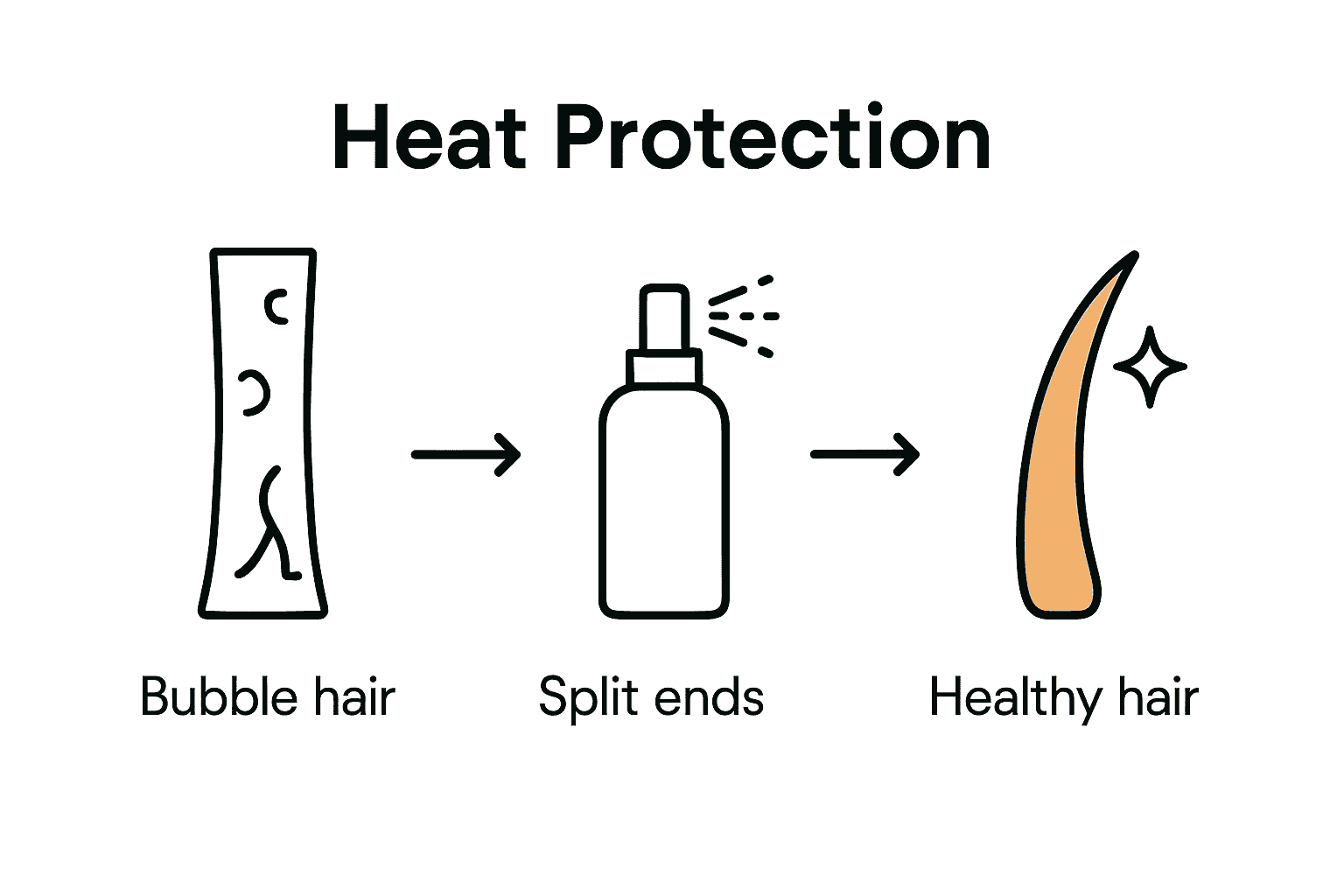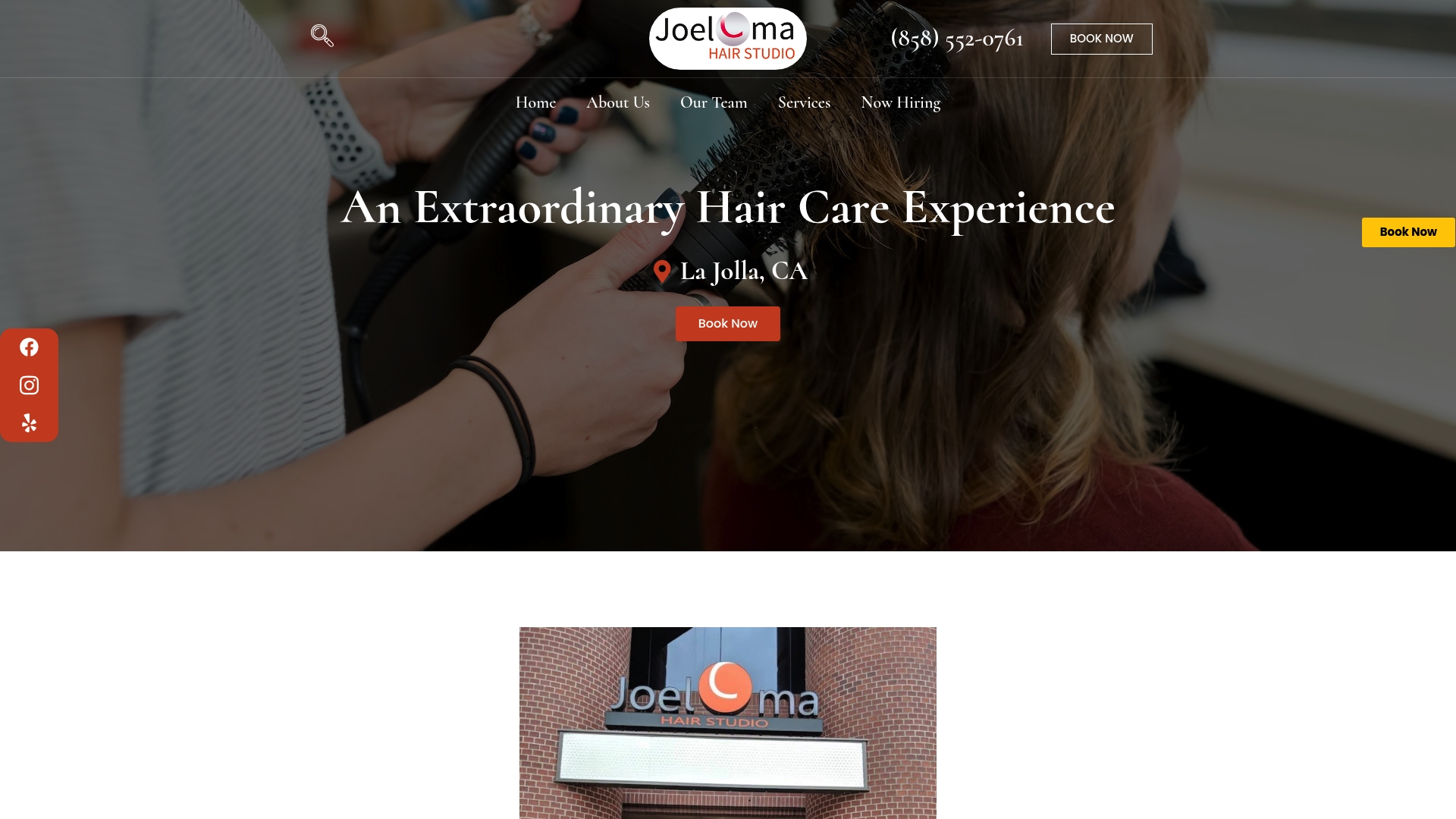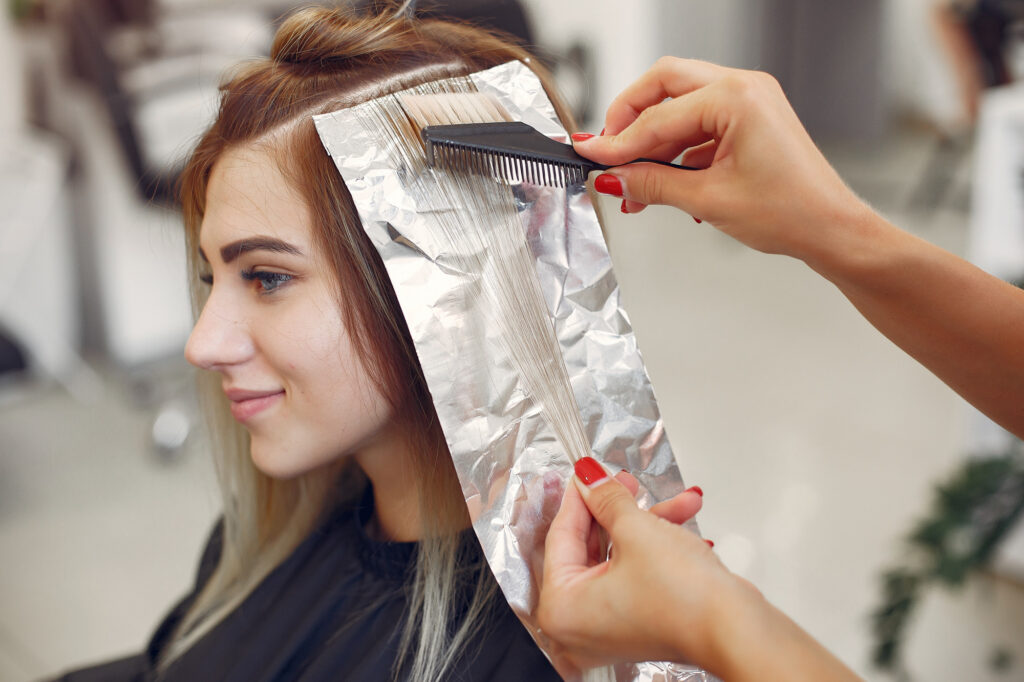Over 80 percent of people use heat styling tools on their hair each week, but few realize the hidden danger lurking behind every pass of a flat iron or blow dryer. Repeated heat exposure can silently erode hair’s natural strength, leading to breakage and lasting damage. Understanding how to shield your strands from this risk can make all the difference in keeping your hair healthy, strong, and visibly radiant.
Key Takeaways
| Point | Details |
|---|---|
| Importance of Heat Protectants | Heat protectants are essential for maintaining hair health, forming a barrier that prevents structural damage during heat styling. |
| Types of Heat Damage | Common forms of heat damage include bubble hair and split ends, which compromise hair integrity and lead to long-term breakage. |
| Effective Heat Styling Techniques | To minimize heat exposure, allow hair to dry completely before styling and consider using alternative styles that require less heat. |
| Choosing Quality Products | Selecting the right heat protectant involves understanding your hair type and ensuring the product offers comprehensive thermal defense and additional conditioning benefits. |
Table of Contents
- Defining Heat Protection For Hair Health
- Common Types Of Heat Damage Explained
- How Heat Styling Affects Hair Structure
- Effective Techniques For Minimizing Heat Exposure
- Choosing And Using Heat Protectant Products
- Salon-Approved Tips For Long-Lasting Hair Protection
Defining Heat Protection For Hair Health
Your hair faces an invisible battle every time you style it with heat. Heat protectants are the secret weapon in maintaining hair’s structural integrity and preventing long-term damage. Think of these specialized products as a protective shield, creating a microscopic barrier that preserves your hair’s natural strength and shine.
According to research from physical chemistry experts, heat protectants work through a fascinating mechanism. They form a coating of polymers—like silicones and polyquaterniums—that function essentially like an “oven mitt” for your hair strands. This protective layer does two critical things:
- Delays heat penetration into the hair shaft
- Distributes heat more evenly across hair surfaces
Scientific studies have revealed even more impressive details about these protective treatments. As research published in molecular hair science indicates, specific polymeric pretreatments can actually preserve hair keratin structure under thermal stress. These advanced formulations do more than just protect—they actively work to:
- Improve moisture restoration
- Maintain cuticle integrity
- Reduce potential breakage from heat styling
The bottom line? Heat protection isn’t a luxury—it’s a fundamental step in maintaining healthy, resilient hair. Your styling tools might look harmless, but without proper protection, they’re causing microscopic damage with every use. Protect what you’ve grown.
Common Types Of Heat Damage Explained
Here’s a summary of common types of heat damage and their effects:
| Type of Damage | Cause | Visible Effects | Long-Term Impact |
|---|---|---|---|
| Bubble Hair | Heat above 125°C on wet hair | Brittle, weak patches | Internal cavities, breakage |
| Split Ends (Trichoptilosis) | Excessive heat Mechanical stress |
Frayed tips Multiple split patterns |
Progressive weakening Compromised hair structure |
Heat styling might give you that perfect look, but it comes with hidden risks that can devastate your hair’s health. Thermal damage is more complex and insidious than most people realize, with multiple ways your hair can suffer from excessive heat exposure.
One of the most dramatic forms of heat damage is bubble hair deformity. According to research, when hair is heated above 125°C while wet, something bizarre happens inside the hair shaft. Air-filled cavities form within the cortex, creating weak, brittle patches that are prone to breakage. It’s like tiny invisible explosions happening in your hair strands—each bubble representing potential structural compromise.
Another common and visible type of heat damage is trichoptilosis, more commonly known as split ends. This condition occurs when thermal and mechanical stress breaks down the protective outer layers of hair shafts. The result? Hair strands that fray into multiple split patterns:
- Feather splits
- Tree splits
- Double splits
Each split represents a point of weakness that can travel up the hair shaft, causing progressive damage. Think of it like a run in a delicate stocking—once it starts, it can quickly spread and compromise the entire structure.
The scary part? These damages aren’t always immediately visible. Your hair might look fine today, but repeated heat exposure creates microscopic injuries that accumulate over time.
Protecting your hair isn’t just about looking good—it’s about preventing irreversible structural damage that no amount of conditioning can fully repair.

How Heat Styling Affects Hair Structure
Hair isn’t just a passive accessory—it’s a complex biological structure with remarkable but delicate molecular engineering. When heat styling tools touch your hair, they trigger a microscopic transformation that can fundamentally alter its core strength and resilience.
According to research from materials science experts, temperature plays a critical role in hair structural integrity. Keratin transformation begins at surprisingly low temperatures. When heat reaches over 150°C, the hair’s alpha-keratin protein structure starts converting to beta-keratin, a process that significantly weakens hair’s natural strength. But the damage becomes truly catastrophic at higher temperatures.
At extreme temperatures—beyond 230°C—something dramatic happens internally:
- Disulphide bonds begin to break down
- Hair’s core elasticity gets permanently compromised
- Molecular structural integrity collapses
Perhaps most alarming is what occurs when heat meets moisture. As hair chemistry researchers explain, applying heat to wet hair can create explosive steam that literally blasts through the hair’s internal structure. This isn’t just damage—it’s microscopic destruction. The hydrogen bonds that give your hair its natural shape and strength start to destabilize, creating permanent changes that no conditioner can fully reverse.

The bottom line? Every pass of that flat iron or blow dryer isn’t just styling your hair—it’s potentially reengineering its fundamental molecular composition. Proceed with caution, and always prioritize protection.
Effective Techniques For Minimizing Heat Exposure
Reducing heat damage isn’t about eliminating styling altogether—it’s about strategic, intelligent hair care that preserves your hair’s natural beauty while minimizing potential harm. Heat management is an art form that requires careful planning and smart techniques.
According to research from professional hair care experts, the first line of defense starts before you even pick up a styling tool. Proper preparation is key. This means ensuring your hair is completely dry before applying any heat. Wet or damp hair is significantly more vulnerable to thermal damage, creating the perfect conditions for structural breakdown.
Your heat styling strategy should include multiple protective approaches:
- Use tools with adjustable low heat settings
- Apply heat protectant sprays before styling
- Schedule regular heat-free styling days
- Experiment with alternative styling methods like:
- Overnight braids
- Foam rollers
- Twist-outs
- Pin curls
Smart styling doesn’t stop when you put down the heat tool. Professional recommendations suggest extending your hair protection strategy to nighttime care. Switching to silk or satin pillowcases can dramatically reduce friction and help preserve your hairstyle while preventing additional thermal stress. By implementing these techniques, you’re not just styling—you’re actively protecting your hair’s long-term health and resilience.
Choosing And Using Heat Protectant Products
Not all heat protectants are created equal. Thermal defense is a sophisticated science that requires understanding the complex molecular interactions between product formulations and your hair’s unique structure. Selecting the right protection isn’t just about grabbing any spray off the shelf—it’s about strategic hair care.
According to hair chemistry research, heat protectants work through an ingenious mechanism. They use film-forming polymers like silicones and polyquaterniums that create a microscopic shield adhering directly to hair strands. These specialized molecules do more than just sit on the surface—they actively delay heat transfer, creating a protective barrier that minimizes thermal damage.
When selecting a heat protectant, consider these critical factors:
- Temperature protection range
- Hair type compatibility
- Additional conditioning benefits
- Ingredient quality
Consumer testing reveals some standout products that offer comprehensive protection:
- Olaplex Volumizing Blow Dry Mist
- Moroccanoil Perfect Defense
- Color Wow Heat Protection Spray
These top-tier products not only protect against temperatures up to 450°F but also provide additional benefits like:
- Reduced drying time
- Improved hair smoothness
- Enhanced hydration
One critical caveat from scientific research: these protective polymers can build up over time. Regular clarifying washes are essential to prevent product accumulation and maintain your hair’s natural health and shine. Think of it like maintaining a high-performance engine—periodic deep cleaning keeps everything running smoothly.
Salon-Approved Tips For Long-Lasting Hair Protection
Professional hairstylists treat heat protection like sunscreen for your hair—an absolute non-negotiable step in maintaining its health and vitality. Thermal defense isn’t just a trend, it’s a critical approach to preserving your hair’s natural beauty and structural integrity.
According to high-end salon experts, heat protection is about more than just applying a spray. It’s a comprehensive strategy that begins with selecting the right tools and products. They recommend investing in salon-grade styling tools with intelligent heat control technologies that can regulate temperatures precisely, preventing thermal damage while maintaining hair’s natural shine.
Top salon professionals suggest a multi-layered protection approach:
- Choose heat protectants specific to your hair type
- Look for products offering multiple benefits like:
- UV protection
- Shine enhancement
- Detangling properties
- Reduced blow-dry time
Experts liken heat protectants to SPF for hair—a universal shield against potential damage. But here’s the insider tip: not all products are created equal. The best salon-approved protectants do more than just create a barrier—they actively nourish and strengthen hair while minimizing heat’s destructive potential.
Your heat protection routine should be as personalized as your haircut. Pay attention to your hair’s unique needs, experiment with different products, and remember that prevention is always more effective than repair. Treat your hair like the precious asset it is—with care, precision, and professional-level strategy.
Elevate Your Hair’s Defense With Expert Care
You have just learned how invisible threats like heat styling tools can silently damage your hair’s natural strength and shine. The struggle to keep hair beautiful and resilient is real. From the article, you now know that heat without proper protection leads to bubble hair, split ends, and irreversible molecular changes. Even the best home care can fall short if you are not using the right products or techniques. What if you stopped hoping for healthy hair and instead guaranteed it with professional help tailored exactly for you?

Choose transformation at the hands of true hair artists. At Joel C Ma Hair Studio, we do more than just style. Our advanced hair services ensure your hair is protected, nourished, and styled using only the safest, most personalized heat management strategies. Benefit from decades of experience and the latest science in heat defense. Start your journey toward healthier, more radiant hair by booking a customized consultation today. Do not wait for damage to appear before acting. Let your hair thrive under expert care.
Frequently Asked Questions
What is a heat protectant and how does it work?
Heat protectants are specialized hair products that form a coating of polymers, like silicones, on hair strands. This coating serves as a barrier that delays heat penetration and helps distribute heat evenly, protecting hair from damage during styling.
How can I minimize heat damage when styling my hair?
To minimize heat damage, ensure your hair is completely dry before using heat tools, use adjustable low heat settings, apply heat protectant sprays, and consider heat-free styling methods, such as overnight braids or twists.
What types of heat damage should I be aware of?
Common types of heat damage include bubble hair deformity, which occurs when heated wet hair forms cavities inside the shaft, and split ends (trichoptilosis), which cause frayed tips and progressive weakening due to thermal and mechanical stress.
How do I choose the right heat protectant for my hair type?
When selecting a heat protectant, consider factors such as the temperature protection range, compatibility with your hair type, additional conditioning benefits, and the quality of the ingredients. Look for products that provide comprehensive protection while enhancing hair health.





